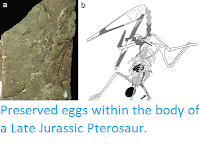The Anurognathid Pterosaurs are small, short-tailed Pterosaurs known from the Jurassic of Asia, Europe, and possibly North America. They has proportionally large eye-sockets, which has been taken as evidence of a nocturnal or crepuscular lifestyle, and spaced, pointed teeth, suitable for catching Insects or possibly Fish, which has led to suggestions that they may have had a lifestyle similar to that of modern Bats.
In a paper published in the Geological Society London Special Publications on 8 September 2017, Junchang Lü of the Institute of Geology of the Chinese Academy of Geological Sciences, and the Key Laboratory of Stratigraphy and Palaeontology of the Ministry of Land and Resources of China, Qingjin Meng, Baopeng Wang and Di Liu of the Beijing Museum of Natural History, Caizhi Shen, also of the Institute of Geology of the Chinese Academy of Geological Sciences, and
the Key Laboratory of Stratigraphy and Palaeontology of the Ministry of
Land and Resources of China, and Yuguang Zhang, also of the Beijing Museum of Natural History, describe a new species of Anurognathid Pterosaur from the Early Cretaceous Jiufotang Formation of Jianchang County in Liaoning Province, China (part of the Jehol Biota).
The new species is named Versperopterylus lamadongensis, where 'Versperopterylus' means 'Dusk-wing', in reference to the presumed Bat-like habits of Anurognathid Pterosaurs, and 'lamadongensis' means 'from Lamadong', in reference to the location where the specimen was found. The species is described from a single specimen, preserved on a slab, which is partially disarticulated, but almost complete, lacking only one humerus, some fingers from the left hand and some cervical (neck) vertebrae.
Photograph (a) and line drawings (b) of Versperopterylus. Abbreviations: cav, caudal vertebrae; csk, crushed skull; co, coracoids; dv, dorsal vertebrae; dr, dorsal ribs; f, femur; fot, fourth toe; fi, fibula; ft, first toe; h,, humerus; lj, lower jaw; mc, maniual claw; mcI-IV, metacarpals I–IV; mttI-IV, metatarsals I–IV; mttv, metatarsal V; pt, pteroid; rd, radius; sc, scapula; ti, tibia; ul, ulna. Lü et al. (2017).
The specimen is estimated to have had a wing-span of about a metre. It had an exceptionally small skull, which was wider than it was long, though this is somewhat crushed, obscuring any detail. The upper jaw appears to have had about 12 teeth. One of its toes appears to have been reversed in life, which is likely to have been an adaptation for gripping, which in turn strongly suggests an arboreal (tree-dwelling) life-style.
Artists interpretation of Versperopterylus as a living animal. Zhao Chuang in Lü et al. (2017).
See also...
Follow Sciency Thoughts on Facebook.








